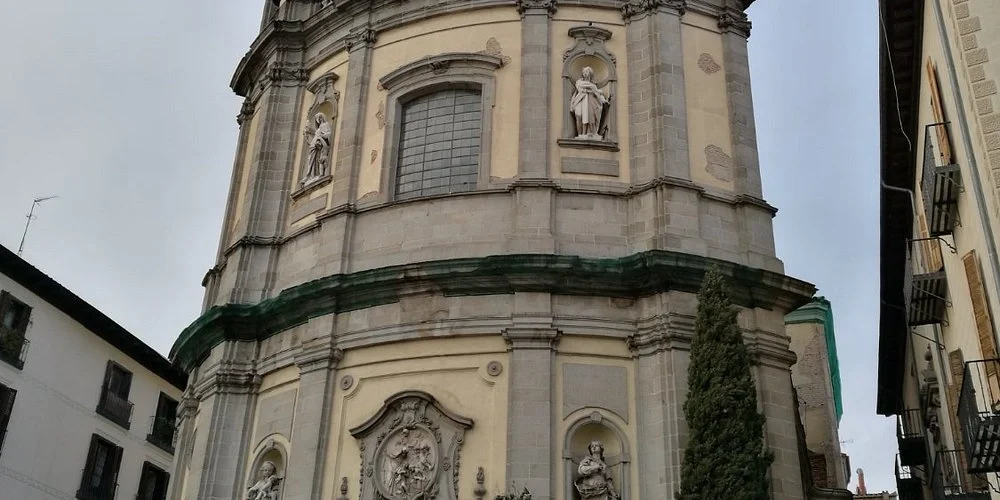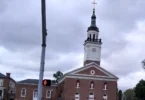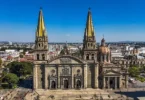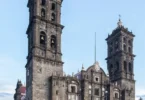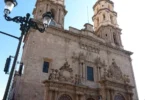Introduction

The Pontifical Basilica of San Miguel, officially known as the Basilica of San Miguel, is a distinguished Baroque-style Catholic church situated at 4 San Justo Street in the historic heart of Madrid, Spain. Nestled adjacent to the Archbishop’s Palace within the renowned Madrid de los Austrias district, this basilica holds significant religious, cultural, and historical importance. Since 1892, it has been closely connected to the Apostolic Nunciature to the Kingdom of Spain, serving as its official church. Throughout its history, pastoral care of the basilica has been entrusted first to the Order of the Redemptorists (from 1892 to 1959) and, more recently, to the Personal Prelature of Opus Dei, who continue its administration to this day.
The basilica serves as the canonical seat for the Sacramental Brotherhood and the Nazarene Brotherhood of the Most Holy Christ of Faith and Forgiveness, as well as Mary Most Holy Immaculate, Mother of the Church, and Archangel Saint Michael. This brotherhood, popularly known as “Los Estudiantes,” is a penitential fraternity that solemnly processes through the streets on the evening of Palm Sunday each year. Recognized for its architectural beauty and religious significance, the Basilica of San Miguel was granted the honorary title of Minor Basilica by Pope Pius XI on October 19, 1930. Later, on November 28, 1984, it was declared a National Historic Artistic Monument, cementing its status as a treasured landmark in Madrid’s rich spiritual and cultural landscape.

Origins and Early History
The current Pontifical Basilica of San Miguel stands on the historic site of the original Parish Church of the Holy Children Justo and Pastor. According to tradition, Saints Justo and Pastor were martyred during the Diocletian persecution in Complutum, present-day Alcalá de Henares. This early church was one of Madrid’s ten oldest, first documented in the Madrid Charter of 1202 granted by King Alfonso VIII of Castile. The original structure was a modest, single-nave building featuring a semicircular apse, constructed in the Toledo Mudéjar style with baked brick as the primary material. The complex also included a multi-story bell tower and a surrounding parish cemetery.
From the 12th century through to the late 17th century, the original church underwent several expansions and renovations, as evidenced in the Texeira Plan, which shows various parish annexes. Despite these efforts, the building gradually deteriorated, and by the early 18th century, it was in a state of irreversible ruin. Worship was temporarily moved to the nearby Church of San Pedro El Viejo while plans were made to build a new temple. However, these efforts stalled due to the outbreak of the War of Spanish Succession and the ensuing political instability following the Bourbon dynasty’s accession.
Bourbon Patronage and Reconstruction
The reign of Philip V and the influence of his wife, Queen Isabel de Farnesio, marked a new phase in Madrid’s architectural and cultural development. In 1735, their sixth son, Infante Luis de Borbón y Farnesio, was appointed Cardinal Archbishop of Toledo at the age of eight. The queen tasked the Marquis of Scotti, a trusted tutor, with finding a prestigious site in Madrid to build a grand new church. This temple was intended not only to serve as the venue for important archiepiscopal ceremonies but also to symbolize the Bourbon dynasty’s imprint on the city’s architectural heritage. Construction began on September 20, 1739, under the direct patronage of Queen Isabel Farnese. The project was led by Italian architects Santiago Bonavía and his disciple Virgilio Rabaglio. The building was consecrated in 1746. The design and decoration—featuring an iconographic program dedicated to Saints Justo and Pastor—represented a harmonious blend of late Italian Baroque and emerging Neoclassical styles. The queen’s generous financial support ensured the basilica’s artistic and architectural uniqueness, including its exceptional interior acoustics, which remain intact today and create an extraordinary “music box” effect.
18th and 19th Century Developments
Following a devastating fire in Madrid’s Plaza Mayor in 1790 and the ruin of the nearby Church of San Miguel de los Octoes, the basilica absorbed both parishes, serving as their joint headquarters until 1892. The late 19th century brought significant changes. The demolition of the Hospital de los Italianos in 1883, the creation of the new Diocese of Madrid in 1885 (separating it from Toledo), and the strengthening of diplomatic ties between Spain and the Vatican culminated in the Spanish state officially transferring ownership of the basilica to the Holy See. As a result, the original parish of Saints Justo and Pastor moved to the Church of Our Lady of Wonders, while the Parish of San Miguel relocated to a new building on General Ricardos Street.
Pontifical Status and Modern Administration
The transfer of ownership marked the church’s elevation to a pontifical basilica under the title of Saint Michael the Archangel, patron of heavenly armies and Vatican diplomacy, during the papacy of Leo XIII and the tenure of Nuncio Angelo di Pietro. Pastoral care was initially entrusted to the Congregation of the Most Holy Redeemer (Redemptorists) and later, in 1959, to the Personal Prelature of Opus Dei, which continues to administer the basilica today. The basilica was officially declared a Minor Basilica by Pope Pius XI on October 19, 1930, and recognized as a National Historic Artistic Monument on November 28, 1984.
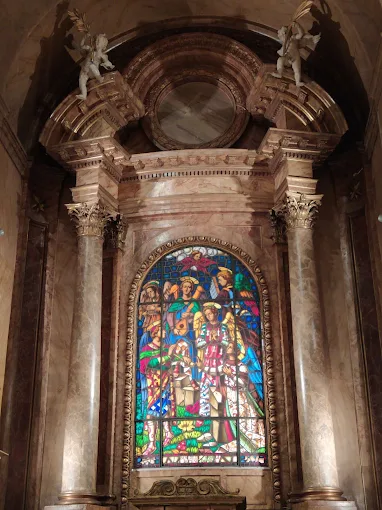
Artistic Highlights and Notable Facts
The basilica’s original plans are attributed to Santiago Bonavía, possibly with earlier input from Teodoro Ardemans, and completed by Virgilio Rabaglio. The facade features allegorical statues representing Charity, Faith, Hope, and Fortitude, sculpted by Roberto Michel and Nicolás Caresana. Caresana also created a prominent panel on the facade depicting the martyrdom of Saints Justo and Pastor. The cupola is adorned with frescoes painted in 1745 by Bartolomé Rusca, illustrating the apotheosis of the titular saints. A noteworthy historical detail is the crypt burial of the Italian-born composer Luigi Boccherini, a parishioner of the basilica who died in Madrid. His remains were interred in the basilica until 1927, when Benito Mussolini ordered them transferred to Boccherini’s hometown of Lucca, Italy.
Architecture of Pontifical Basilica of St. Michael, Madrid, Spain

Architect : Santiago Bonavía
Architectural style : Baroque architecture
Architectural Design and Exterior Features
The Basilica of San Miguel is designed with a Latin cross floor plan, primarily the work of Italian architect Santiago Bonavía. Although the initial commission was given to Spanish architect Teodoro Ardemans, who produced preliminary designs, the project was ultimately completed by Virgilio Rabaglio. One of the most distinctive features of the basilica is its striking convex façade, which is crowned by two towers with slender spires showcasing an oriental influence. The façade is further accentuated by a gracefully curved pediment, creating a dynamic visual effect uncommon in Madrid’s architectural landscape. The façade is richly adorned with sculptural groups that emphasize the basilica’s religious symbolism. Four allegorical figures representing Charity, Faith, Hope, and Fortitude, crafted by sculptors Roberto Michel and Nicolás Caresana, decorate the upper sections. Above the main entrance, a finely detailed bas-relief by Caresana depicts the Martyrdom of Saints Justo and Pastor, to whom the original church was dedicated.
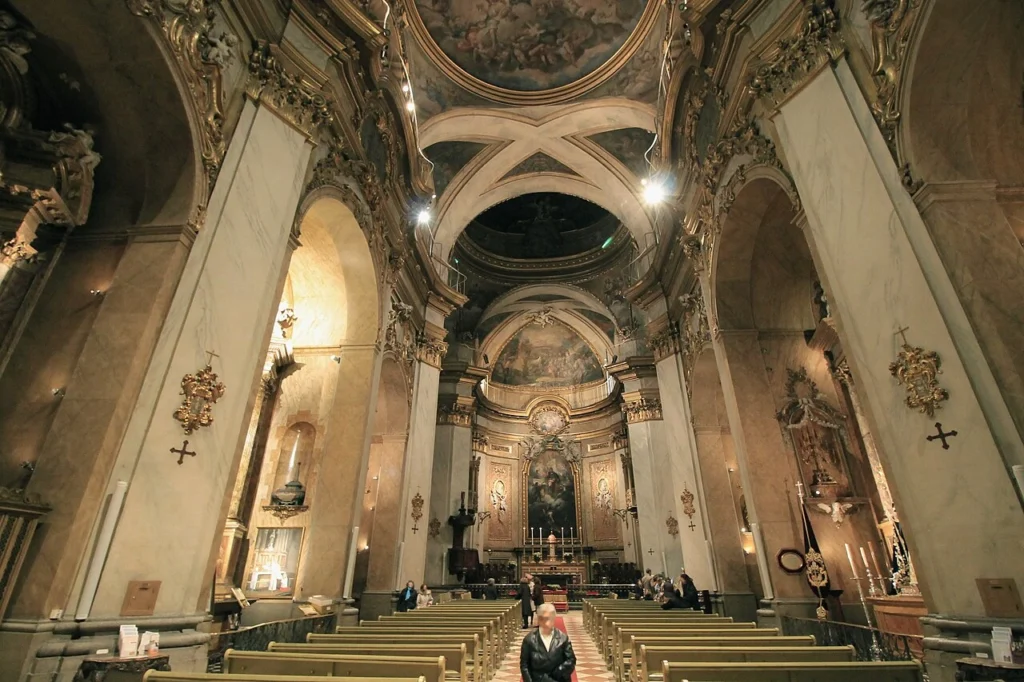
Interior Architecture and Spatial Composition
Inside, the basilica showcases a sophisticated interplay of architectural elements that create both balance and movement within the space. The single nave is characterized by a tension between concave and convex surfaces, combined with alternating circular and elliptical forms, alongside sections featuring crossed arches. An oblique arrangement of pilasters and columns offsets the central axis, while the main arches intersect in a cross shape under the vaulted ceiling. The nave is topped by a lowered dome, supported by reinforced groin pendentives framed between two straight sections with crossed arches. The transept features an elegant oval dome resting on a balustraded ring. The presbytery is covered by a groin vault and a quarter-sphere vault, enhancing the spatial complexity and visual depth.
Decorative Elements and Frescoes
The interior decoration is particularly notable for its frescoes and painted artworks, largely completed in the mid-18th century. Bartolomé Rusca painted the nave vaults in 1745, depicting the heavenly apotheosis of Saints Justo and Pastor. The pendentives feature representations of the four virtues—Charity, Faith, Hope, and Fortitude—while the triangular sections at the front and rear showcase prophets Elijah, Jeremiah, David, and Isaiah, painted by the artist Hatoy. Additional frescoes by the Velázquez brothers—Luis, Antonio, and Alejandro—decorate the pendentives and dome of the transept as well as the area above the presbytery. These works depict the Four Evangelists, the Presentation of Saints Justo and Pastor before the Tyrant, and their Martyrdom. Flanking the presbytery, Hatoy’s paintings portray the archangels Barachiel, Gabriel, and Jehudiel on the left side, and Uriel, Raphael, and Sealtiel on the right. Complementing the frescoes are several grisaille paintings positioned above the transept and side altarpieces, combined with an elaborate scheme of simulated marble and stucco decorations. The raised choir at the entrance end features a flat ceiling, adding to the layered architectural complexity.
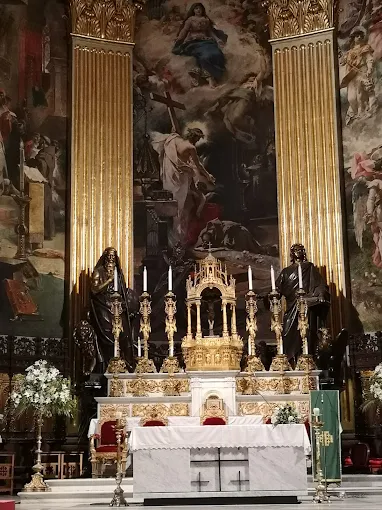
Side Chapels and Altarpieces
The basilica’s shallow side chapels once housed classical altarpieces from the late 18th century. These were reconstructed in the 20th century, with some partially replaced by confessionals after the church’s administration transferred to Opus Dei. These chapels included modern sculptures and, in certain cases, stained-glass windows. The presbytery itself contains a large canvas dedicated to Saint Michael, painted by Alejandro Ferrant in 1897.
Notable Sculptures and Religious Artifacts
Among the most treasured wood sculptures in the basilica is the Most Holy Christ of Faith and Forgiveness, created in the 18th century by the sculptor Luis Salvador Carmona. This revered image is carried in procession every Palm Sunday by the Brotherhood of Students, known as “Los Estudiantes,” and is the first procession of Holy Week in Madrid. Art historian Elías Tormo also noted the presence of a “very beautiful” crucifixion sculpture of Santa Librada by Carmona within the basilica, along with a statue of Saint Pascual Bailón attributed to the same artist, although these may have been relocated.
Burials
The basilica’s crypt was once the resting place of the renowned Italian composer Luigi Boccherini, who died in Madrid. His remains stayed here until 1927, when the Italian dictator Benito Mussolini ordered them to be repatriated to Boccherini’s hometown of Lucca. He was subsequently interred in the Church of San Francesco in Lucca’s pantheon of illustrious citizens.
Feast Day
Feast Day : 29 September
The feast day of the Pontifical Basilica of St. Michael in Madrid, dedicated to Saint Michael the Archangel, is celebrated on September 29th. This date corresponds to the Feast of Saints Michael, Gabriel, and Raphael, Archangels, commonly known as the Feast of the Archangels.
Church Mass Timing
Monday to Friday : 7:25 AM , 10:30 AM , 12:30 PM , 6:30 PM , 8:30 PM
Saturday : 10:30 AM , 12:30 PM , 6:30 PM , 8:30 PM
Sunday : 10:30 AM , 12:30 PM , 1:30 PM , 6:30 PM , 8:30 PM
Church Opening Time:
Monday to Sunday : 9:45 AM – 1:15 PM, 5:30 PM – 9:15 PM
Contact Info
Address : Pontifical Basilica of St. Michael
C.de San Justo, 4, Centro, 28005 Madrid, Spain.
Phone : +34 915 48 40 11
Accommodations
Connectivities
Airway
Pontifical Basilica of St. Michael, Madrid, Spain, to Cuatro Vientos Airport, distance 21 min (14.7 km) via A-5.
Railway
Pontifical Basilica of St. Michael, Madrid, Spain, to Madrid Puerta de Atocha-Almudena Grandes,, distance between 10 min (3.5 km) via C. de Bailén.

